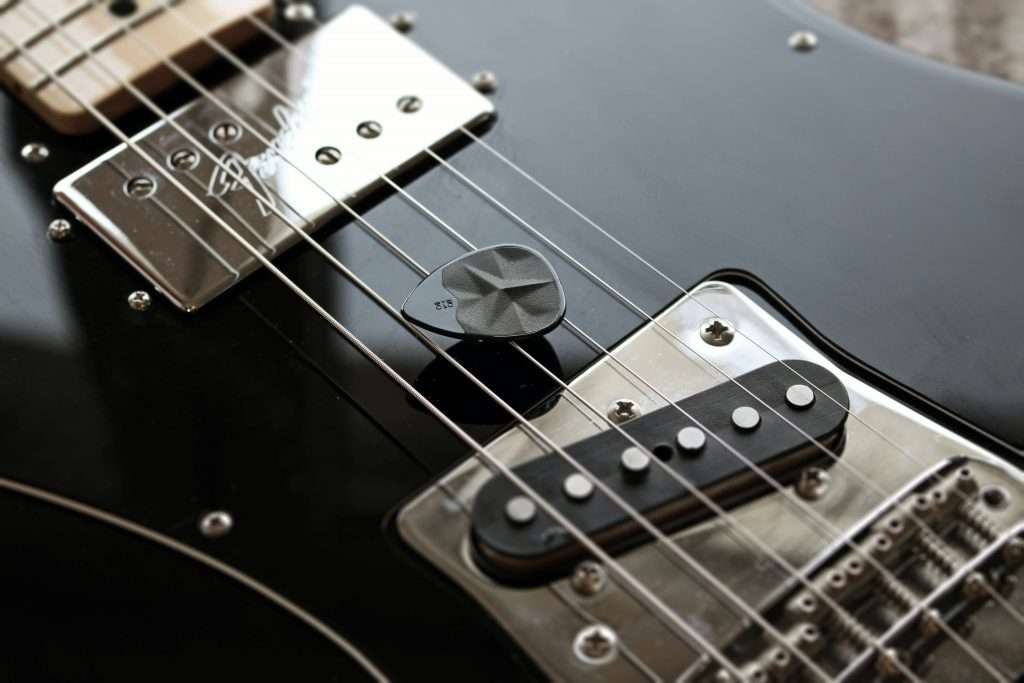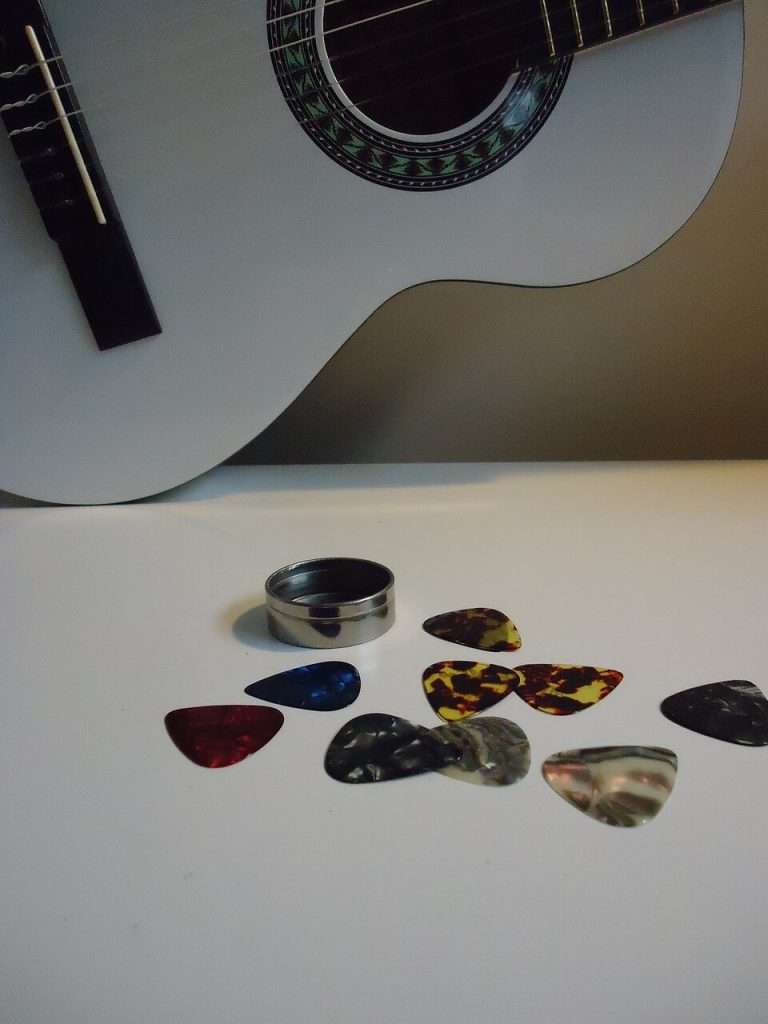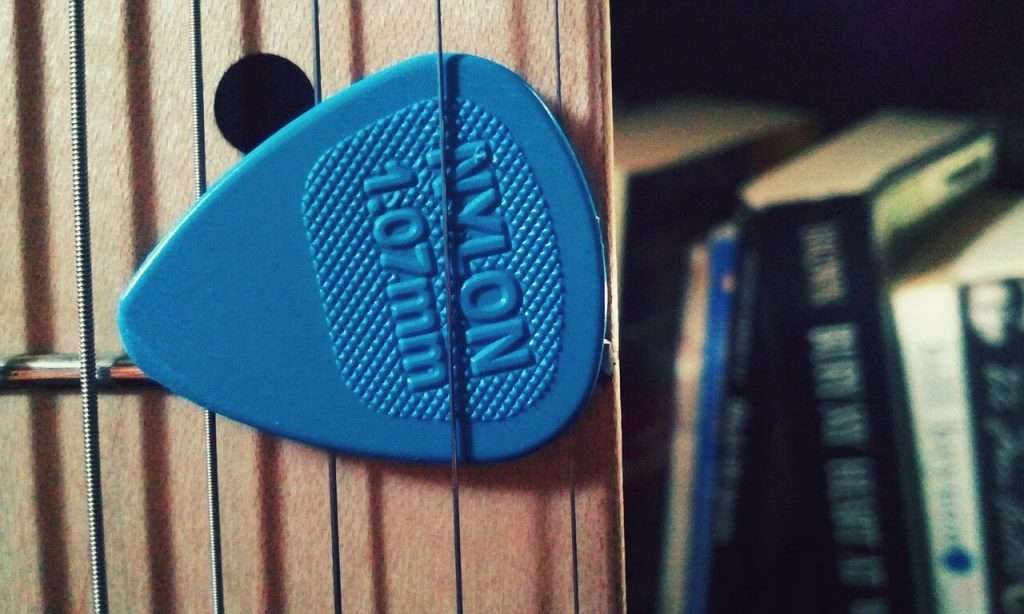
In this article we’ll see how many materials are available for the picks, and what possibilities you have when searching for a new and/or more exotic guitar sound.
SYNTHETIC MATERIAL
As the name says, these are made with plastics, resin or other synthetic materials.
NYLON
Nylon is a very flexible material, used for decades and typical of early rock, blues, jazz and other genres where it was very popular for decades.
These can give a mellow and soft sound, but also a good treble: in general, they’re very flexible both in the material and in the sounds that it can produce.
They usually allow more flexibility and durability, with a completely different sound from the “natural” materials – but in fact, even different kinds of plastic can change a lot the sound.
Let’s dive in into these now.
DELRIN
Delrin is a material that was designed in order to mimic the hardness and texture of tortoiseshell picks (very popular until they became outlaw), and is one of the most common material nowaday.
This material has several names, and it’s also called:
- Acetal
- Polyacetal
- Thermoplastic
- Duraplex
- Duralin
This plastic is one of the hardest, between all the synthetic materials, and therefore is very durable; in some cases, though, it can be slippery (but many brands insert a grip-section for better usability).
Its sound is in the middle of bright (with a good treble) and low-end, giving an equilibrated sound; the main brands that have a delrin pick in their catalogue are Jim Dunlop (with their Delrin 500 or Gator Grip, for example), Ernie Ball (Everlast Delrin Picks), D’Addario (Duralin guitar picks) or Fender.
CELLULOID
Usually recognisable for their pearl-like aspect, this material is harder than nylon but softer than tortoiseshell (as celluloid was another “imitation” for this outlawed material).
Its sound is very clear and bold, with more high end compared to other plastics but with a good amount of mid and low-end too.
This material is very common and popular, so nearly every famous brand has its own take on this material.

ACRYLIC
These offer a complete sound, giving more articulation and sound complexity compared to other picks, and a bright and high-end sound.
Despite this articulation, though, they are more slippery than usual, even more when hands are sweating: for this reason, the acrylic of the pick is often coated with a layer of another material, for better grip, or they are provided with a grip section.
The most “famous” for this type are the V-Picks (where the acrylic is mixed with other materials) and the Gravity Picks.
TORTEX
This a plastic material developed by Dunlop (in fact many claim that they are actually made with Delrin, but other say that it’s made with delrin and some other “secret ingredient”), with the purpose of replacing tortoiseshell material.
They are very affordable, non-slippery even with sweaty hands.
The sound is very balanced and versatile, and for this reason has been used for decades by all kind of guitarists – for blues, rock, metal and lots of other genres and sounds.
You can easily find one at Dunlop, and you can buy lots of them for a very cheap price.
ULTEM (or also ULTEX)
These are made with a new kind of plastic that gives extra durability, with a sound similar to the balanced sound of the plastic picks but with a more convenient price and grip.
A brand that has a good variety of these picks is Dunlop, with their Standard Ultex serie, the Triangular, the Sharp or the signature Ultex series, such as Hetfield’s one.
POLYAMIDE-IMIDE (DRAGONHEARTS PICKS)
This material is pretty much unique and used only by Dragonhearts brand, after many (a lot, actually) tests with other synthetic and plastic materials.
The main characteristics of this material are:
- Low friction coefficient (that makes it easier to play fast with much less resistance during the picking);
- High erosion resistance (more durable and cost-effective);
- warm and soft sound, despite having a clear attack
Another characteristic of these models are the 3 picking points, that let you choose for a shred-like style, a strumming one or a lead, each one with a different shape in the pick.
TUSQ
Tusq picks are made with organic polymers (without petrouleum and therefore without any plastic) in order to imitate ivory’s sound (now illegal), and with a sound that reminds of a vintage tortuoise shell (illegal too).
These picks have 3 different level of harmonics, giving bright, warm and deep sounds alltogether: in general, it gives a richer mid and upper range of sound frequencies, with a bright treble and a strong sound.
THERMOPLASTIC
One of the main commercial names for this material is the Thermex, used for providing a warm sound (with lots of low-frequencies) with a durable material.
It’s not a very common one, but if you want to try one you can try the Taylor DarkTone Serie Pick Tin.

NATURAL MATERIALS
METALLIC PLECTRUMS
These have a very long duration and a bright sound, but can often wear out the strings when used.
STAINLESS STEEL
This consists in non-magnetic steel, that gives you a very aggressive sound and is super-durable (some players use the same steel model for 10-20 years because of the extreme resistance of the material).
Something to consider is that when we pick we wear out the strings, and for this reason using one of these will cause the need for a more frequent strings replacement; beyond the strings, it can also damage the finish of the guitar when we strum, eventually damaging the pickguard too.
If you’re still willing to try one of those, you can use the Jim Dunlop model.
COPPER
Copper picks have one of the brightest sound between metallic picks, and is often mixed with small parts of other metals, in order to avoid deterioration and most importantly for avoiding a change in the shape of the pick, because when picking the strings it can wear out easily.
With the many hardening “ingredients” added to the mix, though, these become very durable and long-lasting.
If you’re looking for one of those, you can check out the brand of Zenfirepicks.
BRASS
Brass has a predominant high-midrange, with exceptional treble and good mids: for this reason, it’s one of the most common metallic picks.
As always with metallic picks, though, it can damage strings very fastly too.
One of the brands that produces those is the Timber Tones.
SILVER
Silver is a very rare material, and it’s quite uncommon to find it in your usual guitar store.
You can still find it online, though: Fender actually has a model, the FENDER® STERLING SILVER 351 GUITAR PICK, and despite being smaller (and probably too much fragile to actually play it) it can give pretty bright sounds.
You can see more at the Fender official page.
ALUMINUM
Like for all metallic materials, an aluminum pick can give you a bright sound with a full and strong treble, but with the benefit of a long duration.
For the aluminum, another upside is very lightweight, while other metallic ones are usually heavier when used for picking, and they wear out the strings but not as much as other alloys and metals.
A famous and good serie for this material is the Teckpick from Jim Dunlop.
GOLD
This isn’t (obviously) a common material used by many guitarists, but as you’ve probably seen so far there are tons of options and possibilities when we talk about guitar picks.
Pure gold picks are definitely insanely costly, but there are also gold-plated models, that have a metal body with a (very) thin of gold: these are described as cristal-clear sounding and providing a strong sound, perfect for rock and metal.
One model that you can check out for example is this.
NEODYNIUM
This a magnetic metal, that has his own magnetic field and therefore it’s quite unique as a material, compared to other materials in this page’s list (well, not for the rarity, where the most unique is the meteor, but at least sound-wise).
As with other metals it give a bright sound, but the main perk is the ability to use magnetic fields when you play: you can even “pick” without picking, just by moving the pick near the strings.
You can also use other cool effects, and explore lots of uncovered sonic possibilities (this is also called a multi-effect material for his unique characteristics).
Delay, Rotary sound, tremolo and octaver can be achieved only by using that plectrum alone, without even having a pedalboard.
If you’re interested you can check the official creator’s page on KickStarter for the X-Pick

OTHER NATURAL MATERIALS
TORTOISESHELL
Those picks are now banned (because the hawksbill turtle, the turtle from which this material was taken, is now an endangered animal) but they were very popular in the last decades.
Their fame was because of the good grip and the rich sound, but nowadays there are a lot of materials made just in order to mimic the sound of this illegal shell (for example Delrin).
TAGUA
Tagua is a nut from the area of Colombia/Equador, and the fruits of this plant hang in the air like coconuts and, despite the fruits in the inside having a gelatinous texture when harvested, after 4 weeks they turn and harden, becoming of a similar texture of animal ivory.
Being fully renewable (as a plant) these picks are very eco-friendly and also very similar to bone, ebony and ivory.
Their main characteristics are:
- durability;
- porous (they can be slippery, and for this reason they often come with a grip section);
- high thickness – they mainly come with 2.2-2.7 mm thickness
If you want to try one for yourself you can check Howlingmonkeyspicks website.
COCONUT SHELL
These guitar picks are fully eco-friendly and obviously very hard, without any flexibity at all.
They are usually thick (beyond 2.0 mm) and with warm tones.
You can check out these at Timber Tones or Elmntpicks.
GEMSTONE
Crystals are used for high-hardness guitar picks, and lots of guitar pick’s options are available for this material.
There are lots of different gemstones, for example:
- Amethyst;
- Amazonite;
- Aventurine;
- Black Onyx;
- Quartz;
- Fluorite;
- Amazonite
You can find these picks with several brands, such as Elmnstpicks.
BUFFALO HORN
Buffalo horn is a very hard material and suitable for both electric and acoustic guitar.
Its sound is warm and with a good mid-range sound, giving a smooth and strong sound.
If you want to see more, you can see Timber Tones brand.
OBSIDIAN
These picks are very hard and, as stone, don’t become excessively slippery.
They usually have a thick “Body” and a more subtle playing tip, and they give a warm sound.
They can also wear out strings faster than soft materials, and is recommended for electric guitar alone, and not acoustic.
You can find some obsidian picks here.
BONE
Bone is probably familiar to many guitar players, as it’s used in nuts and saddles.
As a pick, though, it can be used mainly for electric guitar, and is used for his hardness and bright sound, very similar to the tortoiseshell’s sound.
One of the main brand for this material is Timber Tones manufacturer.
WOOD
There are many types of wood used, with different textures and stiffness.
Their sound is usually very rich and articulated, but their downside is the difficulty of playing due to the hard material and the very low flexibility.
The main ones are:
- teak (made from Clayton Picks brand);
- Olive wood (for example the serie “Alnicov 3 Pcs Wooden Guitar Picks, Olive wood);
- Rosewood (sold by ThaliaCapos, for example);
- Ebony;
- Mango Wood;
- Steembeech;
- Purple Heart;
- Indian Rosewood;
- Coconut wood;
- Bamboo;
- Bakan;
- Acacia;
- Blackberry;
- Maple;
- Padok;
- Jackwood;
- Tamariad;
- Oak
Lots of these materials are sold by Fu-Tone, ThaliaCapos and Clayton.
FELT
Felt models are made with both high-density cotton and wool, and they are actually with medium-level stiffness: their main areas, though, are bass and ukulele-playing.
Their sound is balanced, with more middles than lows and trebles.
RUBBER
Rubber models are mainly recommended for acoustic or classical guitar: they sound much like fingers, with a warm tone and a very natural feel.
They usually come in many levels of stiffness and thickness (as well as normal models), and are usually easy to hold with a great grip level.
One good model is the Wedgie WRPP31M, that also help to reduce pick noises when we play.

ABALONE
This material provides a hard pick, not flexible, with a bright sound and a focus on high-end frequencies and a boost of the treble.
Because this is a hard material, it is recommended for the use on an electric guitar.
One of the few vendor is the brand Timber Tones (their model is designed with the shape of a Classic Jazz III model).
CARBON FIBER
Carbon fiber provides a durable pick with a bright sound.
Those aren’t exactly common as a material, and for this reason there are few models (but more than lots of the options in this page, though).
One that’s good is the Dunlop MAX-GRIP Jazz III Carbon fiber pick.
GRAPHITE
The main perks of this particular material are the smooth and soft attack, a full and balanced tone and a long duration.
The graphite is also mixed with other materials in some cases: one of the materials used with this material is Nylon (this mix is used in the Telefunken’s “Graphite Enriched Delrin” serie).
If you want a graphite-only one, though , you can use the Dunlop’s “15RAP Adams Graphite“(that is also used by Grateful Dead’s guitarist Jerry Garcia).
CERAMIC
Ceramic picks are another option in the modern day’s guitarist for a different sound, but most of these are actually made from a mix of ceramic and other materials, such as Nylon.
In general, they have an even sound, balanced and with just a bit more treble in the EQ, but nothing that actually dominates the overall sound.
A model of ceramic-nylon that you can check out is the Pick-Boy Pro Pick Ceramic.
GLASS
They give a bright sound, usually recommended for Arch Top Jazz Guitars.
They’re quite uncommon and there are few vendors, beyond the indipendent sellers on several websites: a brand that provides those is Timber Tones brand.
METEOR
There are very few guitar picks in the world that are made using a meteor, the Gibeon meteorites, discovered in Namibia in the 1936.
The sound is described as a bold sound, and today there are very few models that are often sold out: Starpics, Stoneworkspicks and other independent vendors sell these true space’s rarities.
VEGAN MIXED PLANT-BASED RAW MATERIAL
These are made with vegan materials, completely derived from plants.
They are not-so-common, but you can find one at a relatively cheap price (under 5$ generally), for example at Pigtrum.
AGATIZED DINOSAUR BONE
As you can already guess by the name of the material, this is an extremely rare material and with very few information about it.
You can check the availability on the Stoneworkpicks website, but they are often out of stock.
LEATHER
This material can simulate a fingerstyle-like sound, with warm sound with lots of low frequencies and a unique attack during the picking.
It can also give more nuanced sounds than plastic, stone or felt (according to reviews).
You can check out more on SkinTone brand’s own website.
